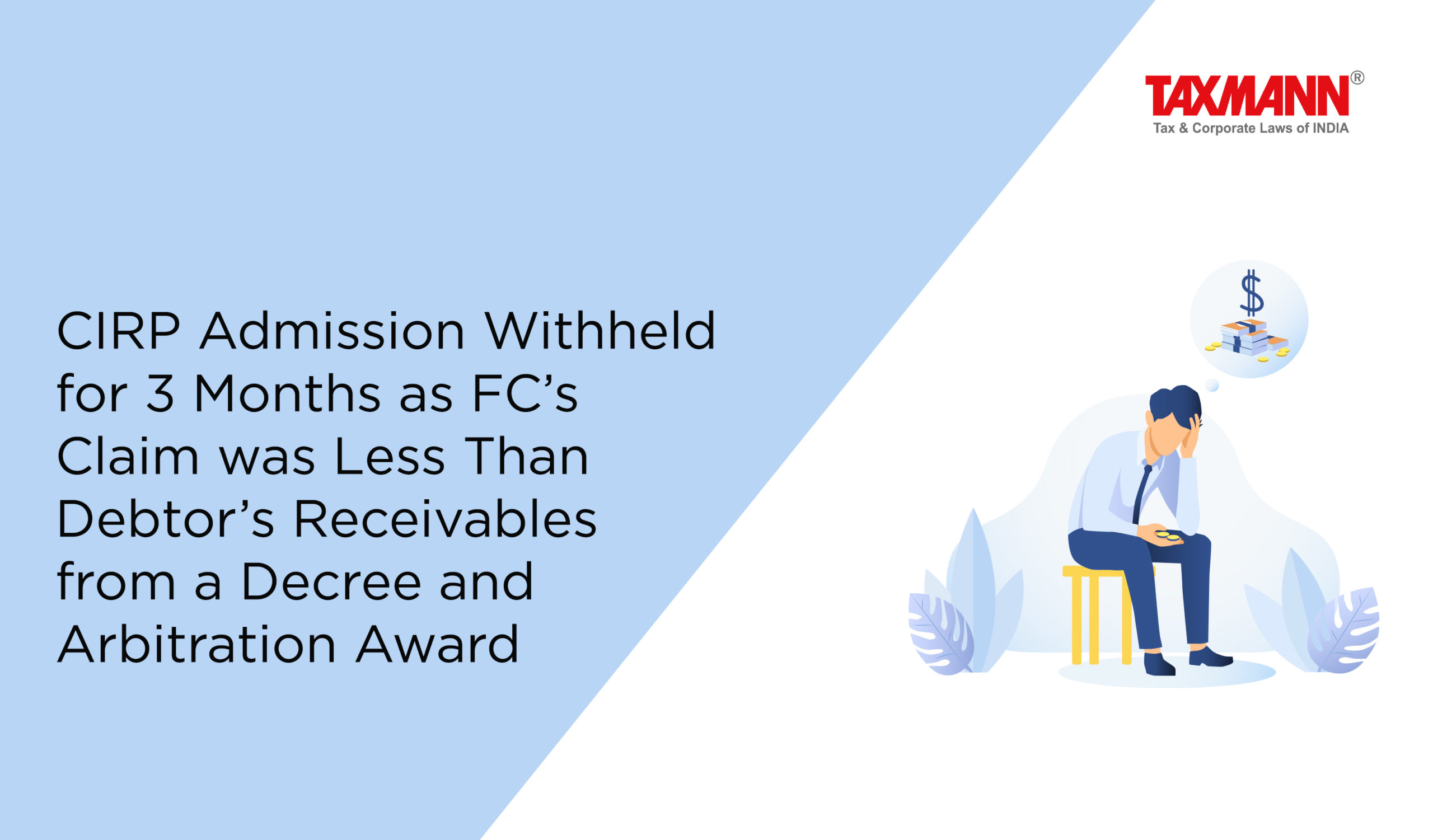CIRP Admission Withheld for 3 Months as FC’s Claim was Less Than Debtor’s Receivables from a Decree and Arbitration Award
- News|Blog|Insolvency and Bankruptcy Code|
- 2 Min Read
- By Taxmann
- |
- Last Updated on 18 July, 2023

Case Details: Srei Equipment Finance Ltd. v. Madhucon Projects Ltd. - [2023] 152 taxmann.com 39 (NCLT-Hyd.)
Judiciary and Counsel Details
-
- Dr N. Venkata Ramakrishna Badarinath Nandulal, Judicial Member
& Charan Singh, Technical Member - Deepak Bhattacharjee, Sr. Adv. & Prasoon Das for the Petitioner.
- Hemendranath Reddy, Sr. Adv. & Prateek Reddy for the Respondent.
- Dr N. Venkata Ramakrishna Badarinath Nandulal, Judicial Member
Facts of the Case
In the instant case, the corporate debtor availed various financial facilities from the financial creditor including a term loan. The financial creditor sent a demand notice to the corporate debtor who defaulted in the timely servicing of principal and interest payments.
The corporate debtor made OTS proposals towards discharge of its liability due to the financial creditor, however the same was rejected. The financial creditor preferred an instant application u/s 7 of the IBC seeking initiation of the CIRP against the corporate debtor on account of non-payment of the alleged debt.
It was noted that a decree for Rs. 163.55 crores and an Arbitral Award of Rs. 52.62 crores were issued in favour of the corporate debtor, which together made the total amount of receivables much greater than defaulted debt, and also the corporate debtor was a running concern.
NCLT Held
The NCLT observed that the onus of getting a particular payment appropriated towards a particular debt is on the debtor. Further, it is not the case of the corporate debtor that it had specifically instructed the financial creditor to appropriate the payments to the term loan under the said contract. So, nothing is wrong on the part of the financial creditor in appropriating the payments towards the earlier debt.
The NCLT held that the admission of the corporate debtor into the CIRP was to be kept in abeyance for three months from the date of the instant order with liberty to the financial creditor to approach the instant Tribunal if its dues continued to remain unpaid.
List of Cases Reviewed
-
- Vidarbha Industries Power Ltd. v. Axis Bank Ltd. [2022] 140 taxmann.com 252/173 SCL 355 (SC)followed.
List of Cases Referred to
-
- Vidarbha Industries Power Ltd. v. Axis Bank Ltd. [2022] 140 taxmann.com 252/173 SCL 355 (SC) (para 5.7)
- Krishna Kilaru v. Maytas Properties Ltd. [2013] 36 taxmann.com 24 (AP) (para 6.2)
- Al Sadiq Sweets v. Krisenter Impex (P.) Ltd. [IBA/35/KOB/2020, dated 26-02-2021] (para 6.2)
- Power Grid Corporation of India Ltd. v. Jyoti Structures Ltd. [2017] 88 taxmann.com 124/[2018] 145 SCL 449 (Delhi) (para 6.5)
- Innoventive Industries Ltd. v. ICICI Bank Ltd. [2017] 84 taxmann.com 320/143 SCL 625 (SC) (para 6.7)
- Canara Bank v. Deccan Chronicle Holdings Ltd. [2017] 86 taxmann.com 52/144 SCL 90 (NCLAT) (para 6.8)
- Canara Bank v. Transstroy (India) (Ltd.) [CP IB/47/2018] (para 6.8)
Disclaimer: The content/information published on the website is only for general information of the user and shall not be construed as legal advice. While the Taxmann has exercised reasonable efforts to ensure the veracity of information/content published, Taxmann shall be under no liability in any manner whatsoever for incorrect information, if any.

Taxmann Publications has a dedicated in-house Research & Editorial Team. This team consists of a team of Chartered Accountants, Company Secretaries, and Lawyers. This team works under the guidance and supervision of editor-in-chief Mr Rakesh Bhargava.
The Research and Editorial Team is responsible for developing reliable and accurate content for the readers. The team follows the six-sigma approach to achieve the benchmark of zero error in its publications and research platforms. The team ensures that the following publication guidelines are thoroughly followed while developing the content:
- The statutory material is obtained only from the authorized and reliable sources
- All the latest developments in the judicial and legislative fields are covered
- Prepare the analytical write-ups on current, controversial, and important issues to help the readers to understand the concept and its implications
- Every content published by Taxmann is complete, accurate and lucid
- All evidence-based statements are supported with proper reference to Section, Circular No., Notification No. or citations
- The golden rules of grammar, style and consistency are thoroughly followed
- Font and size that’s easy to read and remain consistent across all imprint and digital publications are applied





